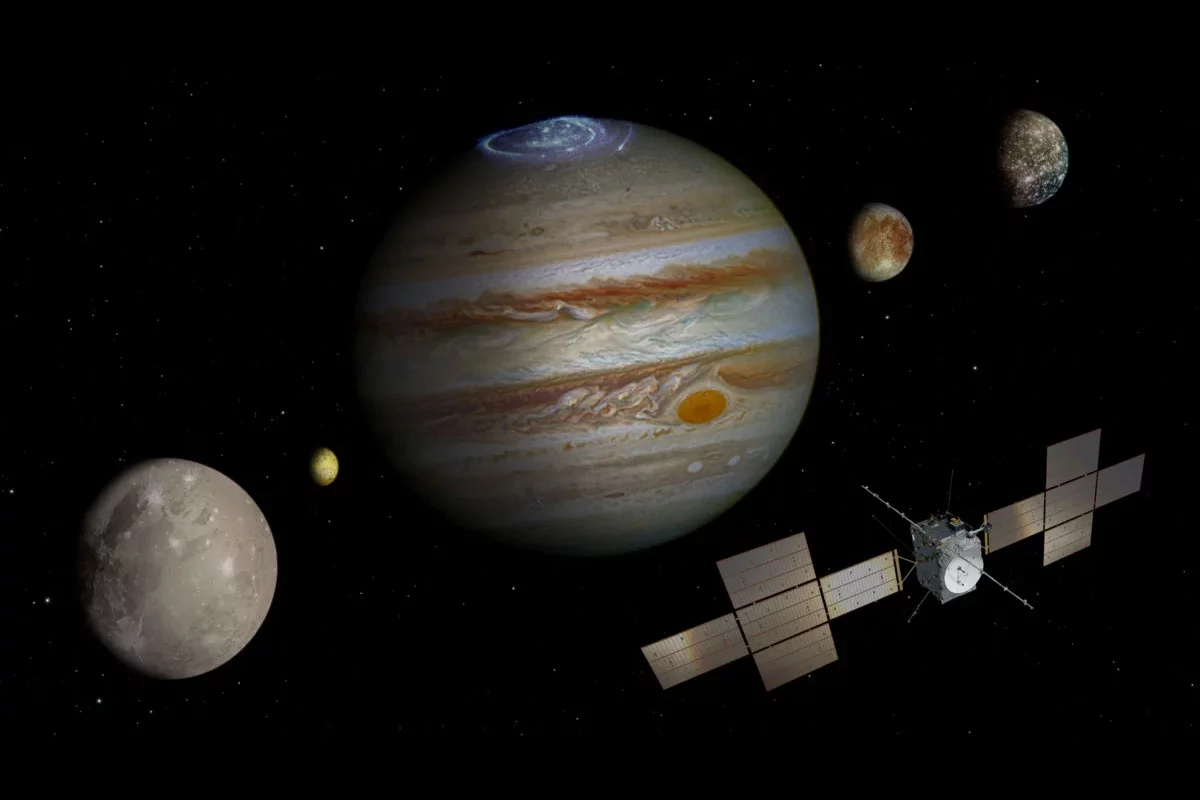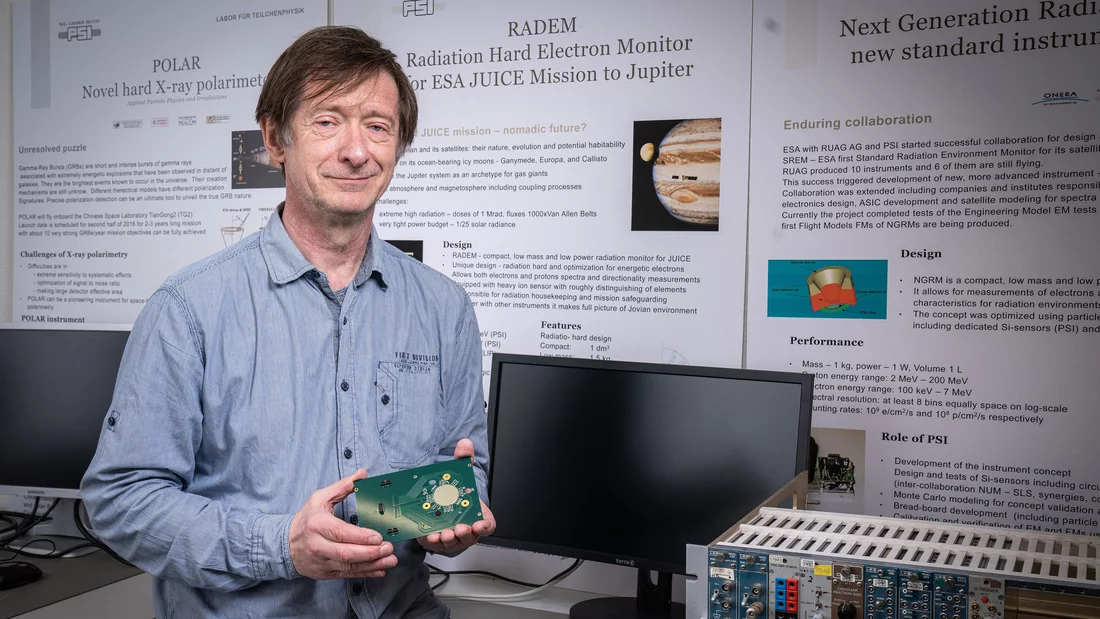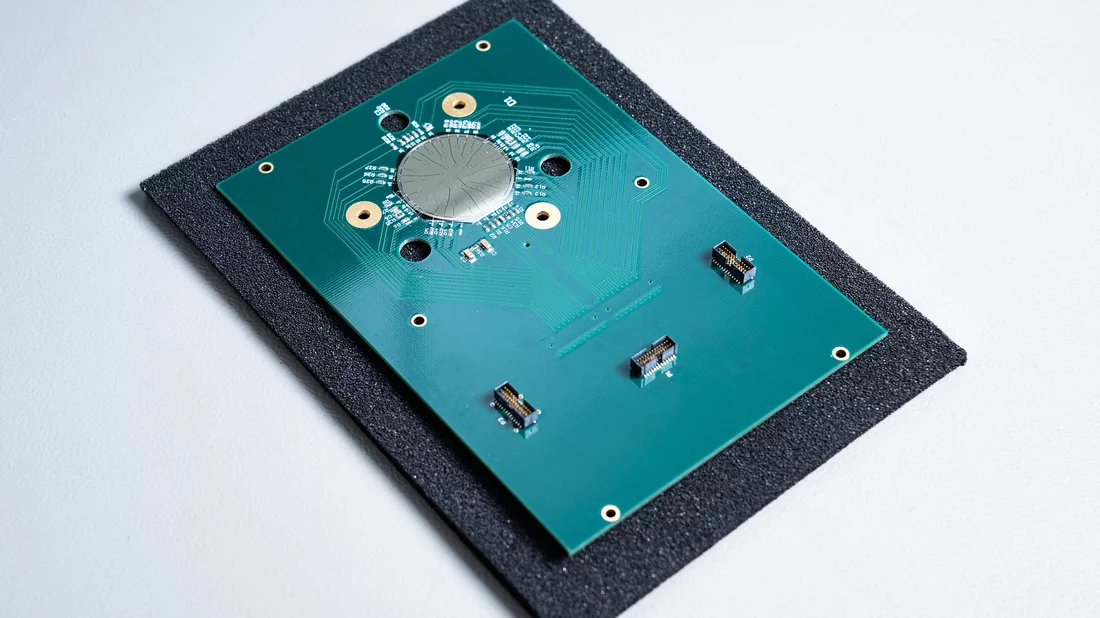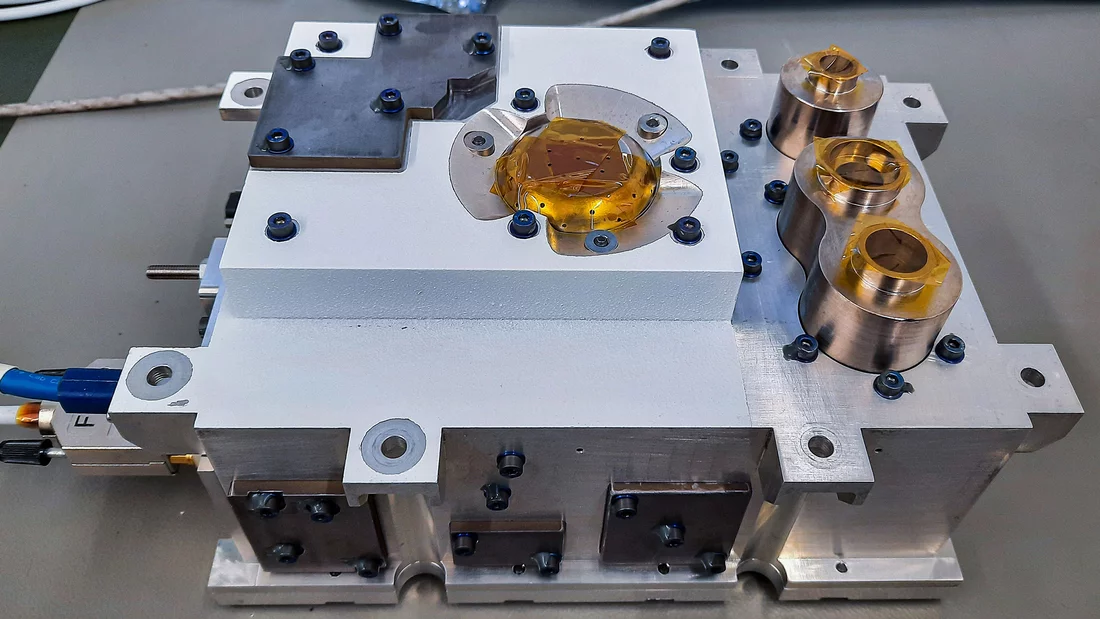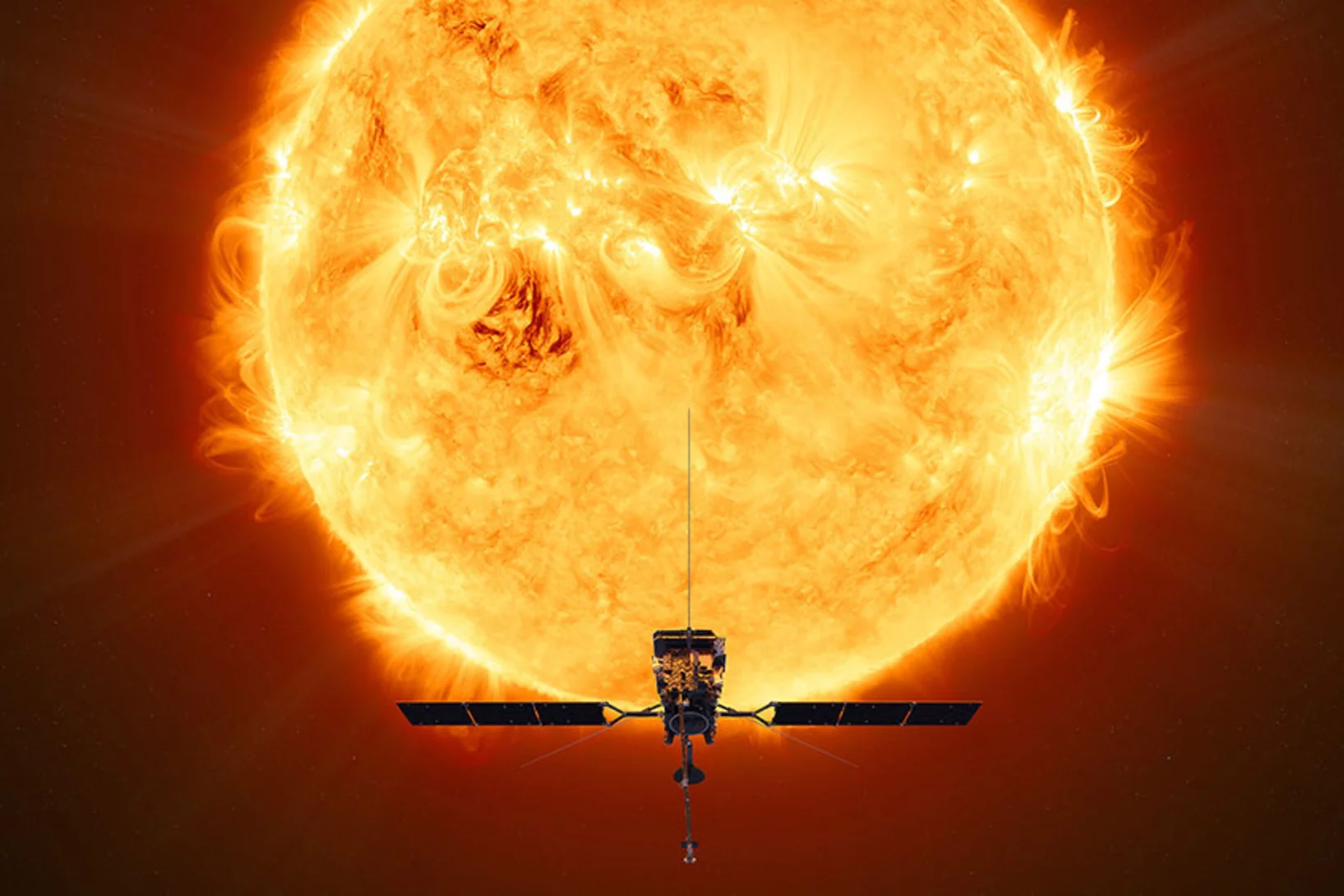The JUICE mission of the European Space Agency ESA, which aims to explore the planet Jupiter and its three largest moons, is all set to go. The space probe will carry on board the high-tech detector RADEM developed at the Paul Scherrer Institute PSI. Among other things, this will provide information about the complex radiation conditions and the highly dynamic magnetic environment of the Jupiter system.
Jupiter is the largest planet in our solar system – a gas giant whose mass is about one thousandth that of our sun. It has more than 80 moons, making it almost like a solar system in its own right. ESA’s JUICE mission will explore its three largest satellites – Ganymede, Callisto and Europa – among others. JUICE stands for Jupiter Icy Moons Explorer, and scientists believe that there may be gigantic oceans and possibly extraterrestrial life underneath the thick icy mantle of these moons. In addition to answering some fundamental questions about the formation of planetary systems, the mission also hopes to find out whether Jupiter’s icy moons provide the necessary conditions for the emergence and long-term existence of life as we know it.
The space probe will take about eight years to reach the Jupiter system. After that, the four-year mission will begin, for which the probe is fitted with eleven extremely complex instruments. One of them has been provided by PSI and was developed under the direction of Wojciech Hajdas in the Laboratory for Particle Physics. The inconspicuous little box by the name of RADEM is compact and weighs three kilograms, looking more like a small car battery than a highly complex particle detector. But appearances can be deceptive: “RADEM stands for Radiation-hard Electron Monitor, an electron monitor that is resistant to radiation and that can detect high-energy particles in Jupiter’s harsh environment,” explains Hajdas.
In the middle of Jupiter's radiation belts
Like Earth, Jupiter has a rotating liquid metal core which generates a magnetic field. When charged particles such as electrons and protons enter this field, they are trapped inside it and accelerated along spiral paths around the planet. This acceleration is many times stronger than on Earth, resulting in high-energy synchrotron radiation, a special form of X-rays. On top of this, atoms and molecules are hurled into space by volcanic activity, which frequently occurs on Jupiter’s moon Io, for example. They become ionised through collisions with the electrons – that is to say they acquire an electrical charge and thus also fall under the spell of Jupiter’s gigantic magnetic field.
Such infernal radiation would be absolutely lethal, not just for human beings – they also pose a great danger to unmanned space probes and their sophisticated electronics. “Some parts of the electronics have been developed explicitly for this mission and are highly resistant to radiation. All the equipment in the probe is also specially clad to withstand the extreme conditions in Jupiter’s radiation belts,” explains Hajdas. “Nevertheless, a prolonged stay in certain zones can lead to damage.” To prevent this, RADEM is directly connected to the probe’s on-board computer. “If the radiation dose exceeds certain limits, the detector triggers an alarm signal. As it is difficult to carry out evasive manoeuvres, particularly sensitive equipment can instead be switched off in such cases, protecting it until the radiation levels are back within the permissible limits,” says Hajdas.
RADEM does not simply serve as an alarm bell, however – its other task is to map Jupiter’s complex radiation belts and gather information about their environment and the particles they contain. “The Jupiter system is completely unique – it is one of the most radiation-intensive environments in the entire solar system; a gigantic, natural particle accelerator,” says Hajdas. “Not only does this provide an in-depth look at the fundamental laws of physics – models of the interactions occurring there could also be applied to other systems, such as solar activity and how it affects Earth’s radiation belts and magnetosphere.”
For its mission, RADEM is equipped with four separate detectors – one for each type of particle: electrons, protons and heavy ions. “The fourth detector registers either electrons or protons,” explains Hajdas. “With an angular coverage of about 35 per cent, it allows us to determine the direction of incidence of these particles and hence the spatial distribution of the radiation environment.” All this data has to be processed and stored within a very short time – and inside a very small space, so as to keep the device as light as possible.
Extraterrestrial life beneath the ice and radiation?
Jupiter’s radiation belts extend several million kilometres into space – the highest particle densities and velocities around the gas giant have been recorded at a radius of around 670 000 kilometres, inside the orbit of Jupiter’s icy moon Europa. At first glance, it may seem paradoxical that a moon travelling along some 780 million kilometres from the sun in such an unreal and icy death zone, should be considered a potential habitat for extraterrestrial life. However, while the radiation makes any life on Europa’s surface impossible, it could lead to chemical reactions through interactions with the layer of ice, which would in turn serve as fuel for life. The lethal radiation would thus indirectly provide energy for microbial life – without photosynthesis or the presence of hydrothermal vents.
“The data collected during previous missions and from observations made from Earth have led to numerous speculations and calculations about the existence of life on Jupiter’s moons,” explains Hajdas. “JUICE will help us to better understand the complex Jupiter system. It’s not a matter of finding life, it’s about gaining a better understanding of the environment to determine whether it is a possible or impossible habitat for life.”
RADEM will also monitor space weather
Many of the instruments included in JUICE will remain switched off during the eight-year voyage, but RADEM has work to do during the journey too: it is to measure the radiation within the solar system and determine how it relates to solar activity. “Between Venus and Jupiter, RADEM will determine the particle spectra and their doses in space and thus map an important parameter for the so-called space weather in this region,” Hajdas explains. The sun is constantly flinging particles into space. These can not only cause radiation damage to satellites, but also disturb the Earth’s magnetic field. Fluctuations in these currents can lead to excessively high voltages in electrical power grids and thus to blackouts. “The activity of our sun follows a regular cycle of about eleven years – during this time it fluctuates between a period of quiescence and a phase of more frequent solar storms. RADEM should help us to understand these activities better, and how they influence our planet and future missions, such as a potential manned mission to Mars,” explains Hajdas.
This is why, unlike similar expeditions, the JUICE mission is being carried out during a so-called solar maximum – i.e. a period of high solar activity. To ensure the detector remains fully functional during this journey and especially during its stay in the Jupiter belt, it had to undergo several stress tests during its development. “With its large research facilities, PSI offers unique opportunities for simulating radiation exposure in space,” explains the particle physicist. “The Proton Irradiation Facility PIF, the proton accelerator HIPA and a special vacuum chamber for low-energy electrons allowed us to create conditions similar to those that exist in space and prepare RADEM for its mission in the best possible way.” Other research institutions involved in the mission, such as the University of Bern, which also developed two detectors for JUICE, brought their equipment to PSI for the beam tests too.
PSI’s renowned large research facilities have been the source of unique insights with regard to the development and operation of particle detectors – knowledge that can be applied not only in laboratories, but now also in the vastness of space on this important mission.
About the JUICE mission
The space probe JUICE is expected to reach the Jupiter system in July 2031, after a voyage lasting about eight years. The system is located almost 780 million kilometres from the Sun – an icy and dark world. The temperature on the surface of the icy moons can drop as low as minus 140 degrees Celsius.
JUICE will first head for the moon Ganymede – the main target of the mission. Ganymede is about one and a half times the size of Earth’s moon, making it the largest moon in the solar system. It is also the only moon in our solar system that generates its own magnetic field – its interaction with Jupiter’s own magnetosphere is of particular interest. Previous space missions and modelling suggest the presence of an ocean deep beneath Ganymede’s 150-kilometre-thick layer of ice. The gravitational interaction with Jupiter could produce energy in the form of heat and with that the conditions that are necessary for life to emerge and to persist. JUICE will complete twelve flybys, approaching to within 200 kilometres of the moon’s surface.
The moon Callisto is also covered with a thick crust of ice. However, it is not certain whether there is also an ocean underneath. Its cratered landscape suggests an absence of any geological activity and that it is probably one of the oldest surfaces in the Jupiter system. In the course of twenty-one flybys, JUICE is expected to come within 200 kilometres of the surface here as well.
In view of its harsh radiation environment, only two flybys of the moon Europa are planned, at a distance of about 400 kilometres from the surface. This surface is much younger than that of Callisto and is constantly being modified by tectonic activity. Compared with Ganymede, the ice crust is much thinner, at about 15 kilometres. The gigantic ocean suspected to lie beneath it is said to contain more water than all of Earth’s oceans combined. Similarities to the Earth’s deep-sea environment suggest that Europa’s oceans might be populated by microbiological organisms. Europa is considered the most promising site for life outside Earth. During its two flybys, JUICE will attempt to take samples of the seawater that erupts from cracks in the ice crust, to analyse these for organic molecules. Those could indicate the presence of life.
In addition to PSI, the University of Bern is the second Swiss institution to support the JUICE mission. For this purpose, it has developed the so-called Neutral Ion Mass Spectrometer NIM to determine the composition of the moons’ atmospheres.
Contact
Dr. Hajdas Wojciech
Laboratory for Particle Physics
Paul Scherrer Institute PSI
+41 56 310 42 12
wojtek.hajdas@psi.ch
[Deutsch, Englisch]
Further information
More articles on this topic
About PSI
The Paul Scherrer Institute PSI develops, builds and operates large, complex research facilities and makes them available to the national and international research community. The institute's own key research priorities are in the fields of future technologies, energy and climate, health innovation and fundamentals of nature. PSI is committed to the training of future generations. Therefore about one quarter of our staff are post-docs, post-graduates or apprentices. Altogether PSI employs 2300 people, thus being the largest research institute in Switzerland. The annual budget amounts to approximately CHF 460 million. PSI is part of the ETH Domain, with the other members being the two Swiss Federal Institutes of Technology, ETH Zurich and EPFL Lausanne, as well as Eawag (Swiss Federal Institute of Aquatic Science and Technology), Empa (Swiss Federal Laboratories for Materials Science and Technology) and WSL (Swiss Federal Institute for Forest, Snow and Landscape Research). (Last updated in June 2024)

